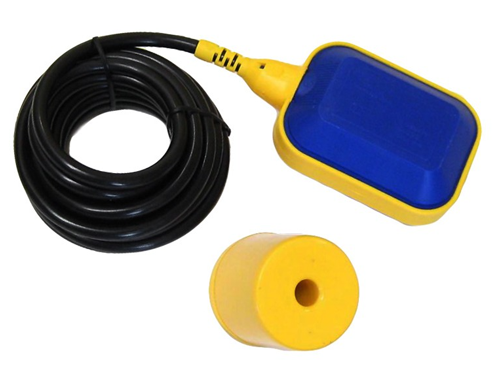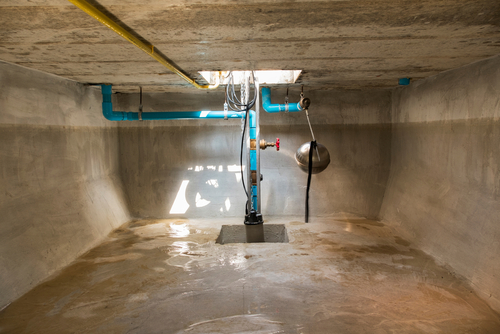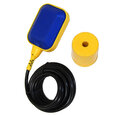Guide to Using Float Switches in Water Tanks

Figure 1: Tethered float switch
Float switches in water tanks operate to prevent spillage and drain the tank at a preset water level. A float switch detects if the water level in a tank is too high or low and controls devices like pumps (by turning them on or off), valves (by opening or closing them), or alarms to notify users. Float switches are widely used in residential, commercial, and industrial settings to ensure efficient and reliable operation of water storage systems. This article explores the different types of float switches available for water tanks and their selection criteria.
Table of contents
- Float switch in a water tank
- Float switches suitable for water tanks
- Selecting the right float switch
- Additional components
- Working
- FAQs
View our online selection of float switches!
Float switch in a water tank
Float switches monitor water levels in the tank and provide real-time information. They help maintain a consistent water level by opening valves to allow water in when it drops below a specific point and closing them when the desired level is reached.
Applications
Several industries use float shut-off switches in water tanks for various applications, some involving liquids other than water.
- Water department: Water towers have float switches, so personnel know the water levels to stay prepared.
- Mining and extraction: Mining and extraction industries use sump pit float switches.
- Transportation: Liquid level switches in fuel tanks constantly monitor fuel levels. Float switches in coolant tanks constantly monitor coolant levels.
Various residential applications use water level switches.
- Well: A float switch monitors water levels in a well to determine if there is enough for use.
- Cistern: A cistern has a float switch that controls filling after a flush.
- Storage tanks: Float switches indicate when water flows into the tank should stop or start depending on the level.

Figure 2: Underground storage water tank
Float switches suitable for water tanks
There are several types of float switches for water tanks:
- Stem-mounted float switches: A stem-mounted float switch moves up and down a stem as the water levels change. One of many floats added to a single stem triggers specific actions based on the water level. Both horizontal and vertical water float switches use these floats.
- Cable-suspended float switches: Cable-suspended float switches rise or sink with the water level as far as the cable allows. Up to four switches can operate at different water levels in a tank.
- Horizontal float switches: Horizontal float switches are common in water tanks with limited access to the top or bottom. These switches mount on the side of the tank; a hinge connects to a fixed section of the housing. A floating switch rises and falls with the water level. It can open or close a circuit depending on the incline of the float. Internal or external installation is possible, depending on the requirements.
- Vertical float switches: Vertical float switches have a stem and a magnetic float. They can have a stainless steel or plastic ball mounted at the top or bottom of the tank. The switches have two floats. One stays at the top while the other moves with the water level. The movement of the lower one triggers the switch to open or close.
- Potable water: Potable water float switches monitor levels of drinkable water storage. These work like the rest of the switches. However, they can work when attached to the outside of the tank. Holding tanks, dispensers, and other water storage containers commonly use potable water float switches.
Selecting the right float switch
Choosing the correct float switch requires considering several factors:
- Tank size and depth: Consider the size and depth of the water tank. Ensure the float switch has an appropriate stem or cable length to reach the desired water levels.
- Switching action: Select a normally open (NO) or normally closed (NC) switch based on the application's needs. A normally open switch activates when the water level rises, while a normally closed switch triggers when the water level drops.
- Operating voltage and current: Ensure the float switch's voltage and current ratings are compatible with the control circuit to prevent electrical issues and ensure safe operation.
- Mounting options: Consider the tank's design, access points, and available space to select a float switch with appropriate mounting options.
- Liquid compatibility: Verify that the materials used in the float switch are compatible with the liquid being monitored. Different liquids may require specific materials to prevent corrosion or degradation. Most water level indicators use stainless steel or plastic.
Additional components
- Valves: Valves control the water flow into or out of the tank. A solenoid valve, connected to the float switch, can automatically open or close based on the water level, maintaining optimal levels without manual intervention.
- Pipes and hoses: Pipes and hoses enable water transfer between the tank, valves, and other water system parts. The size and material of these components depend on the flow rate, pressure, and the application's specific requirements.
- Pump: The float switch can activate a pump to fill the tank when the water level drops below a certain point.
- Control panel: A control panel provides a centralized interface to monitor and manage the water tank system. It may include indicators, switches, and alarms to ensure optimal control and safety.
Working
When water levels change within the tank, the float switch moves accordingly, signaling the control panel or directly controlling other components. For example:
- Water tank filling process:
- The float switch detects low water levels.
- The control system activates the solenoid valve.
- The solenoid valve opens to allow water into the tank.
- The float switch detects high water levels.
- The control system deactivates the solenoid valve.
- The solenoid valve closes to stop the water flow.
- Water tank draining process:
- The float switch detects high water levels.
- The control system activates the solenoid valve or pump.
- The solenoid valve opens, or the pump starts to drain water.
- The float switch detects low water levels.
- The control system deactivates the solenoid valve or stops the pump.
- The solenoid valve closes, or the pump stops, ending the draining process.
FAQs
What is a float switch for a water tank?
A float switch monitors the water level in a water tank. It opens and closes circuits based on the level of the water. The switch operates devices such as alarms and pumps to alert, open, or shut the water supply.
How to get float switch alerts at different levels on a water tank?
Use a stem-mounted float switch. Several floats can be on a single stem. Some vertical float switches also activate switches at different levels.




